Mid-way through our trip along Japan’s Golden Route, we decided to stay at 2 Japanese ryokans to experience traditional Japanese hospitality, onsens, and lifestyle. Ryokans can be commonly found in hot spring areas throughout the country and it’s all about sleeping on futons, smelling the tatami floors, bathing in an onsen, and exploring Japanese cuisine.
For the first ryokan of our trip, we landed on Nishiyama Onsen Keiunkan, which also happens to be the world’s oldest operating hotel. It has been operated by the same family for 52 generations…it’s even older than the imperial capital of Japan, Kyoto.

As this would be our first time in a ryokan, we were looking forward to this novel type of accommodation and all that it has to offer.
Booking
Booking a ryokan is a little more complicated than booking a hotel from a chain. I used the website JAPANiCAN to book one night at Nishiyama Onsen. Ryokans like this don’t come cheap and since we both love taking a soak in the onsen, I sprung for the Special Japanese-style Room with Indoor Hot Spring Bath for ¥90,200 (~$850 CAD) (~$640 USD) for two guests.
For our first ryokan experience, a private onsen, and sleeping on futons were two mandatory requirements for the room type, so we can get the full experience.
You can expect cash rates to range from ~¥57,000–80,000 (~$530–770 CAD) or (~$400–570 USD) per night for a base level room for 2 guests.
Location
Nishiyama Onsen is located in the mountainous prefecture of Yamanashi. The inn is surrounded by mountains on each side and as you can imagine it takes quite the effort to get here if you aren’t travelling by car.
We were travelling from Yokohama to Nishiyama and took the Shinkansen for the first part of the journey to Shin-Fuji station, then walked for around 25 minutes to Fuji station, where we took the Minobu Line to Minobu Station.
The walk from Shin-Fuji to Fuji station was not fun. Many of the roads didn’t have sidewalks and had rough pavement so, rolling a suitcase was not only loud but also difficult with all the bumps. Add on my tech-stuffed backpack, it was a workout for the entire walk. It didn’t help that we were trying to make a train that was leaving Fuji and didn’t want to be late.
For the rest of the journey into the mountains, Nishiyama Onsen provides a complimentary shuttle for its guests – if you stay here, make sure to book that in advance. If you don’t get a ride from the shuttle, you’ll be in for an extremely expensive taxi ride.
The shuttle itself was a pretty stressful experience. There’s only one shuttle a day, and it only goes between Minobu Station and the ryokan. This required leaving Yokohama pretty early and several tight connections in order to make it on time. The shuttle was completely full, not a single seat was left unoccupied. The driver stacked up all of our suitcases Tetris-style at the front of the bus, and some passengers ended up having to store their luggage in the aisle since there wasn’t enough space. Overall it was an extremely tight squeeze and I was amazed everything and everyone managed to fit. Even though the scenery was nice, the one-hour bus ride couldn’t pass quick enough!
Kelly
Initial Impressions
The car/bus ride from Minobu station takes around 1 hour through the mountainside of Yamanashi. I got a little dizzy on the bus so I would advise keeping off your screens until you arrive.
Moreover, the bus was packed to the brim with guests and our luggages, it was not a good start to the experience. I expected more comfort from the transit experience.
Instead, it was so full that pieces of luggage were held in the aisle, stacked high on chairs, and people were packed into small benches without any space.
When we arrived, we were warmly greeted by many ryokan staff that handled all of the unloading, the stay looked to have turned for the better.
Nishiyama Onsen Keiunkan is situated along the Haya River, situated in the gorgeous mountain scenery of rural Japan. There aren’t many tourist attractions or hot-spots in the area. The ryokan is the focus.
The front facia of the ryokan is very understated without any branding or clear indication of what lies inside the Japanese traditional style inn. We were welcomed inside, stored our shoes with the hotel, changed into our provided slippers, and stepped into the historic ryokan.
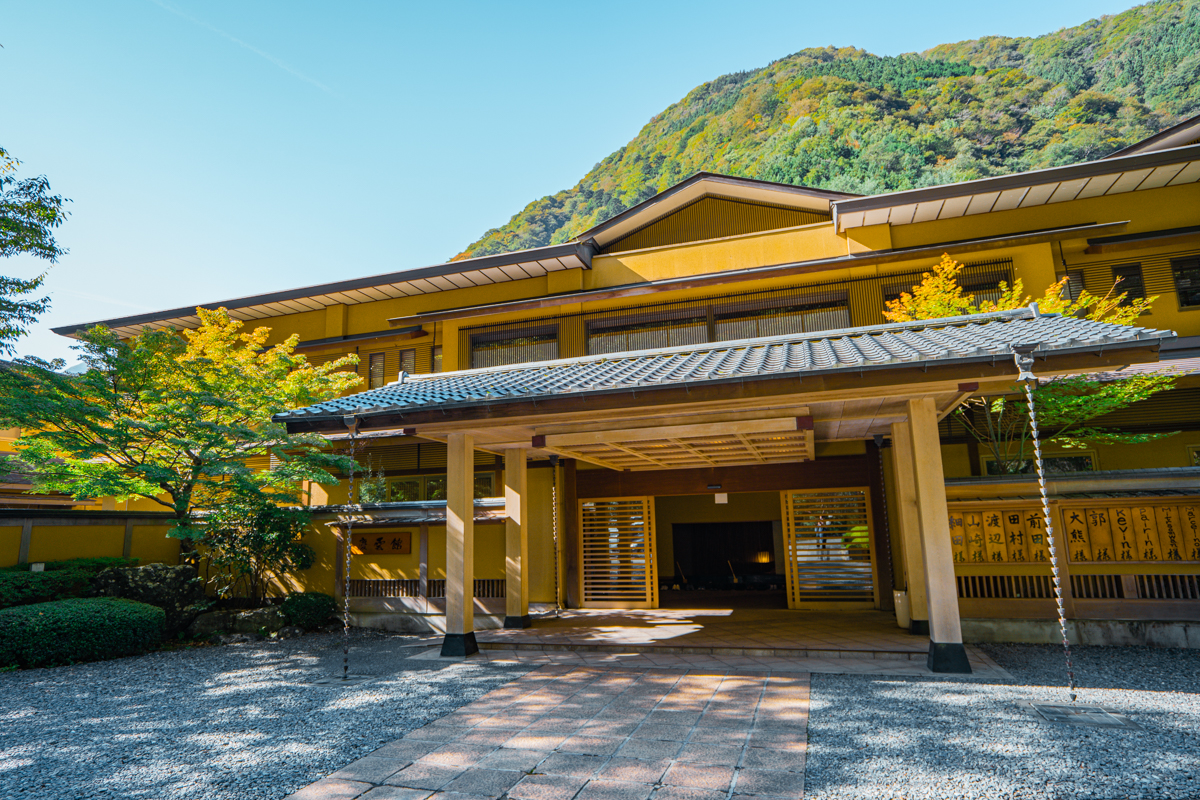
The lobby has lots of seating and large panoramic windows that face the Haya River. To the right is a small gift shop that you can browse for some souvenirs.
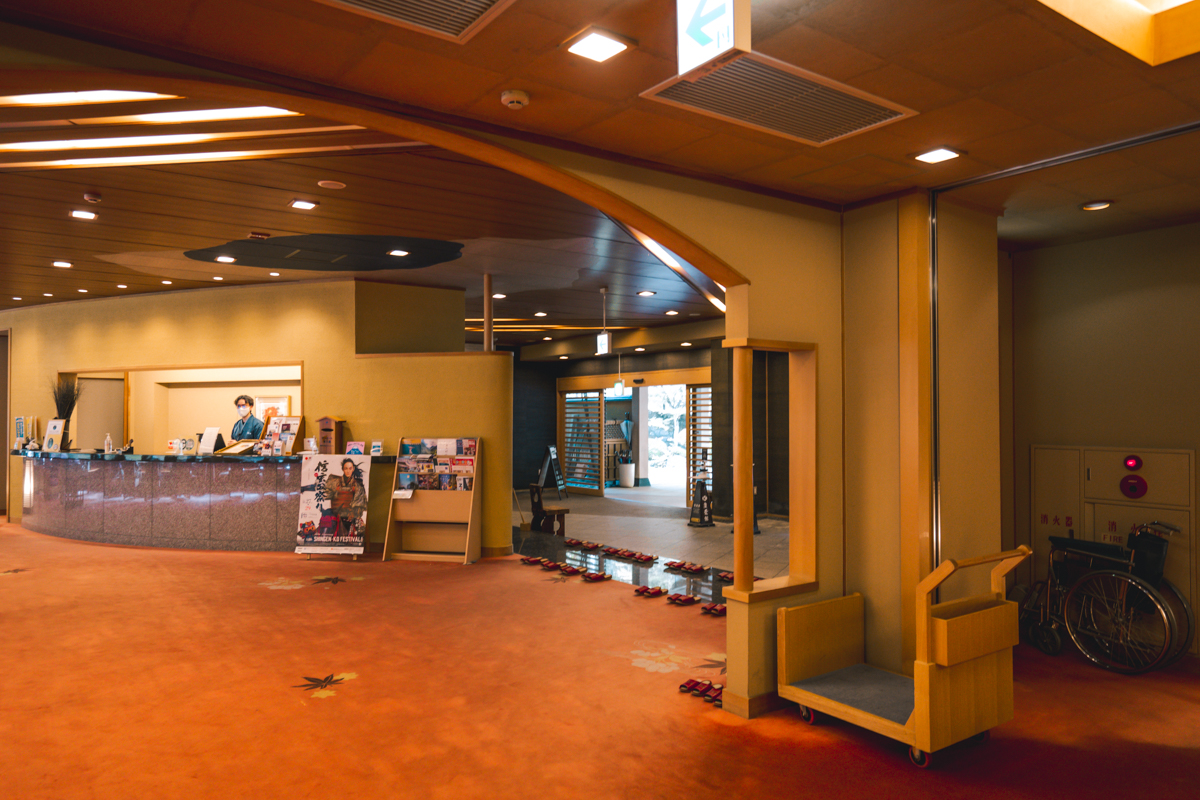
After all of the guests from the bus had changed into slippers and sat down, we were welcomed by a member of staff that led us to room 303, a Japanese-style room with private onsen. There was a custom sign with my name on the door, which was a neat touch.
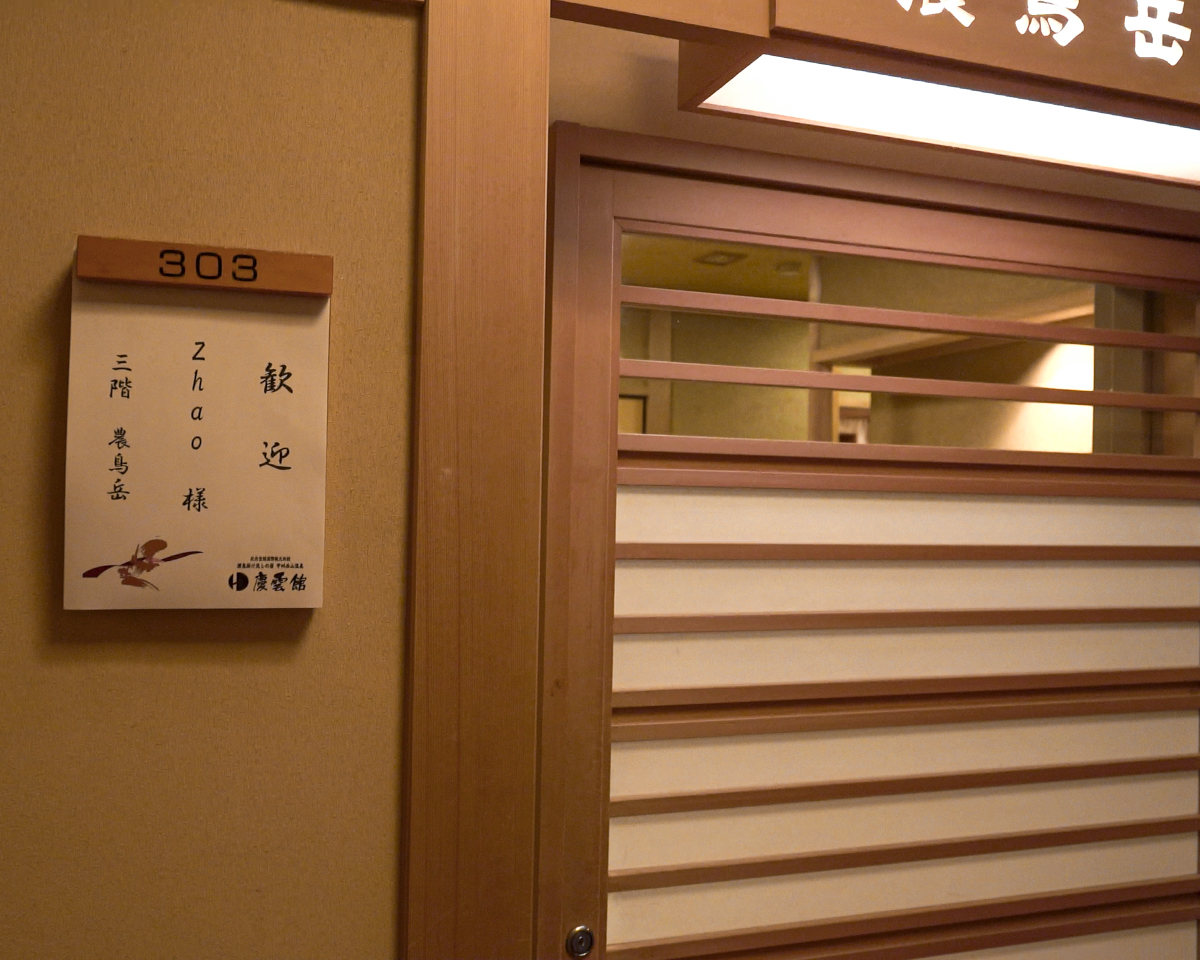
The attendant gave us a tour of our room for the night and led us over to the living room table, where we completed the check-in formalities. We booked our dinner and breakfast times and our private onsen time. Our room came with a small private onsen, but guests are also able to enjoy public onsens separated by gender, and book time slots at a public onsen for private use. This came at no additional charge, and the hotel’s onsen facilities turns out to be significantly nicer than the onsen in our room.
Special Japanese-style Room with Open-air Hot Spring Bath
The room was large, at around 600 square feet with a private outdoor onsen and terrace facing the Haya River.
Stepping in, you’ll first notice the smell and sight of tatami mats throughout the room. Tatami is a historic Japanese aesthetic and material that uses grass and woven straw to achieve a functional yet beautiful look. Tatami exhibits a light earthy smell of dried grass and looks stunning.

From afar, the clean lines and pale yellow hue blends seamlessly into the room and up close you’re able to see each individual woven strand that was crafted into each mat. When you walk atop them, you’ll realize that they are supremely comfortable to walk on barefoot, softer and bouncier than hardwood and much cleaner than carpet.
Tatami mats is more than just a floor covering, it’s a showcase of tradition, craftsmanship, design, and functionality that makes it very impressive.
To the right of the entrance is the toilet room equipped with a Japanese-style bidet toilet and a urinal, which is a very convenient addition.

Opposed to the toilet room is the washroom with dual vanity and loads of Sheseido amenities. Stepping outside the sliding door, you’re presented with the supple sound of water lapping against the floor.

This is where you’ll find the outdoor shower and private onsen. After partaking in dinner and in the larger onsens, we ended the night soaking in this beautiful serene alcove against a backdrop of nothing but the sounds of the forest.

Directly ahead of the entrance is the main living room which will be converted into the bedroom by the staff when we’re at dinner. The living room is very spacious with a central table and two chairs. There’s an oversized window facing the Haya River and leads to a large balcony with 4 chairs and a table.

One of the things you’ll find when you check-in are these stickers which are meant to go on your slippers so you can distinguish which pair are yours when you take them off at the communal onsen.
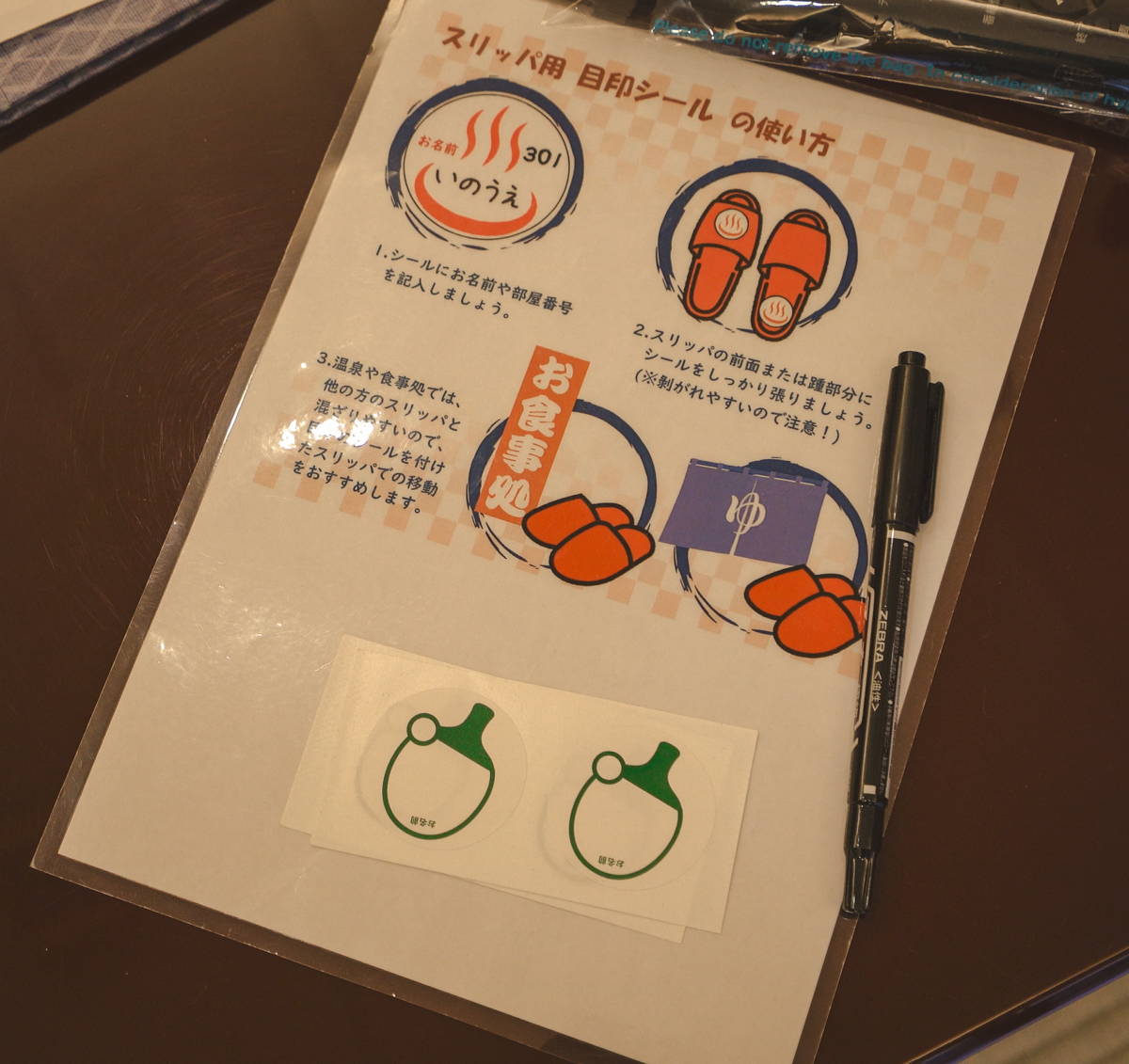
Additionally, you’re also given a satchel which you can use to hold your phone or any miscellaneous items when you go to the onsen as the yukatas don’t have pockets.

Against the right wall of the living room was a Zojirushi water boiler, fresh green tea, and a tea set which we can make tea with.
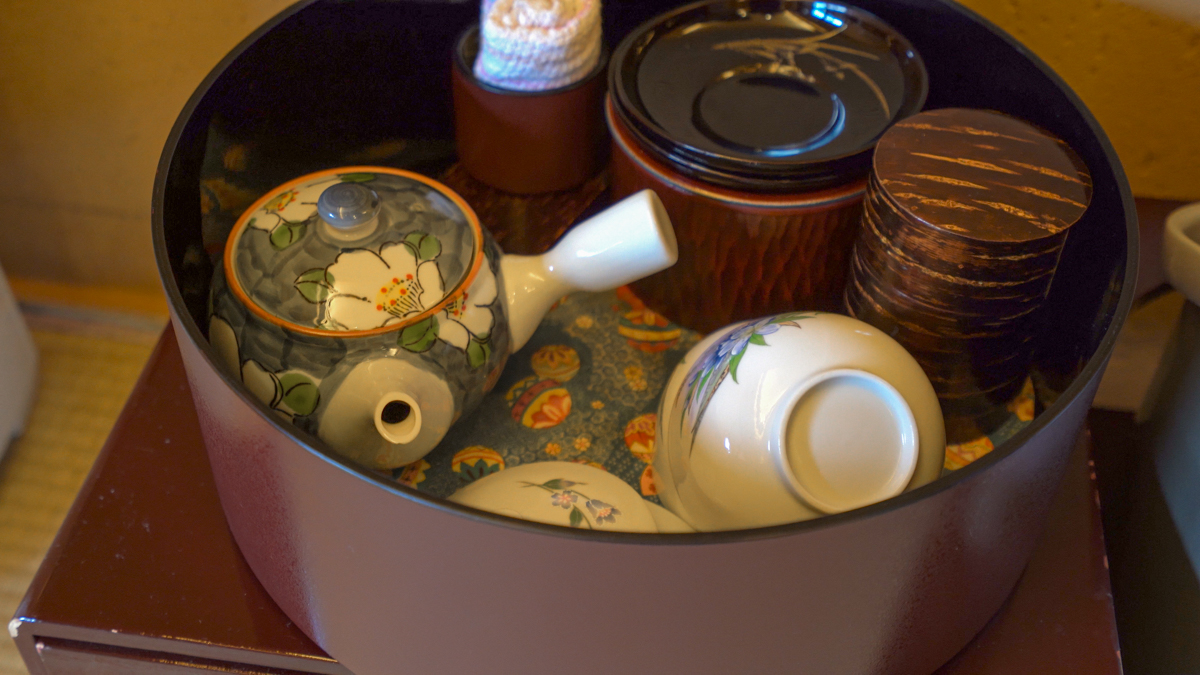
On the far side of the living room was the terrace, it let in lots of natural light and it was super refreshing to be able to step outside and enjoy nature first hand. It provided some amazing views during our stay.

Tucked away in the back and left of the living room is a small sitting room with another low table and two chairs. We used this room to store our bags, charge our devices, converse after dinner, and indulge in some snacks.

In the sitting room, there’s a mirror as well as yukatas that you should change into when you go down for dinner or to a bath. You can even wear them outside, just note that they aren’t super thick so you might be a little cold.
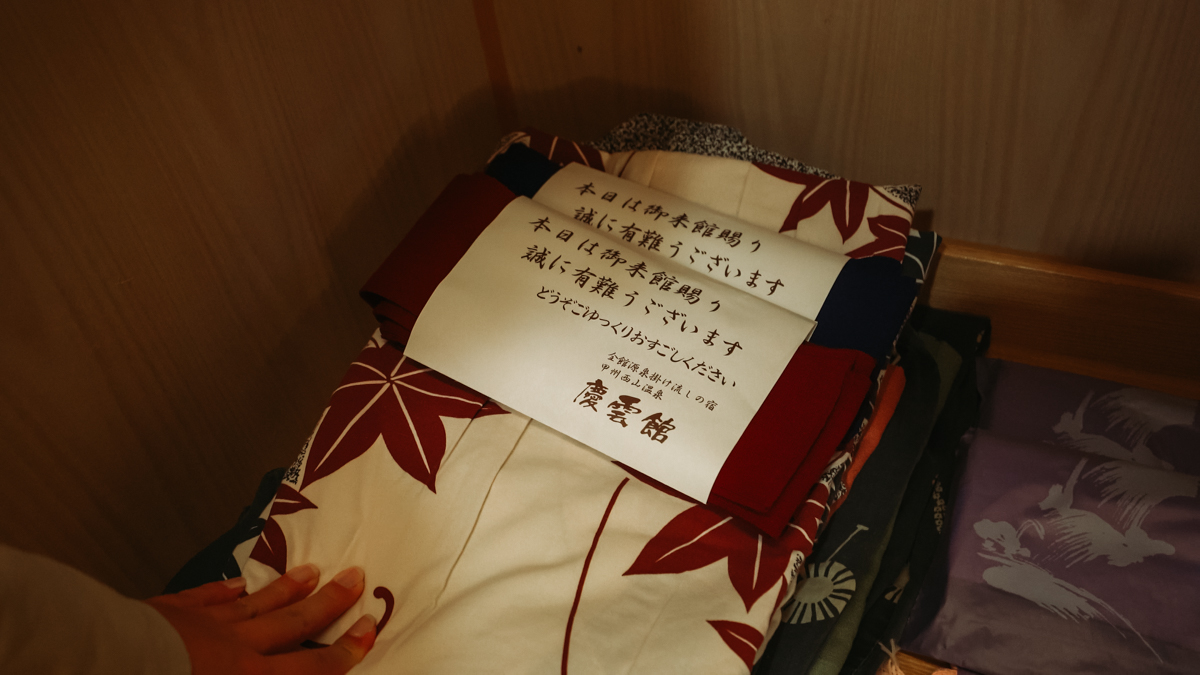
After dinner, the living room was mostly taken up by the two futons and the table was put aside to make room for them. I’m happy to report that while it was our first time sleeping on futons, we both got fantastic sleep and it was super cozy. The oversized marshmallow of a blanket was soft yet not too hot. Perhaps it was the combo of a full dinner and a soak in the onsen that led to such amazing sleep.

All in all, I was a little torn between how I felt about the room. On one hand, it was a very steep price to pay for a nice but pretty normal room, and I didn’t understand why having your own tiny onsen added so much to the cost. On the other hand, I was grateful to be able to experience a Japanese ryokan, the oldest hotel in the world, and take a peek into the vast land of Japanese culture.
Dinner
After checking-in and settling down into our room, we went for a stroll outside around the hotel in our yukatas to get a little bit of walking in before dinner.
Dinner is an elaborate kaiseki affair. Kaiseki is a traditional Japanese multi-course dinner, similar to the set menu’s that we have in Western countries. For those that aren’t super adventurous with their dining, I would advise to bring some snacks just in case. Now what’s the difference between an omakase and kaiseki experience? They both seem similar upon first inspection.
Both omakase and kaiseki dining has a pre-defined menu. But in omakase, chefs can alter and adapt the upcoming courses judging from your reaction to the previous courses. Conversely, kaiseki is a fully fixed menu. Kaiseki is fully focused on showcasing the seasonal ingredients of Japan and is heralded as the haute cuisine of Japan.

We chose to eat at 19:00 and we headed down to our assigned private dining room to find two dining tables already setup with our appetizer of persimmon, salmon roe sushi, boiled maruju in lemon, and lotus root with yam.

Then we were served the sakizuke, which was a small sesame tofu topped with wasabi and some gold leaf, along with a delightful cup of sake. As readers would know, I have an alcohol intolerance and frankly, never drink it unless it’s for a review, or included as part of a larger experience.
This cup of sake was unbelievably smooth and tasty, it was like drinking a cup of nectar with a buzz at the end. If all alcohol tasted like this, I would drink alcohol.

Next up was an eel and root vegetable soup. This was not to my taste. I bet it was healthy but I have a dislike for things that are overly fishy and briny. After trying a few spoonfuls, I hastily decided it wasn’t for me.

Luckily, a bowl of sashimi with salmon, tamago, bean curd, and tofu came to save me. This was served with accompanying real wasabi, soy sauce, and a tangy yellow sauce.


Following the sashimi was minced beef, small eggplant, and okra served in a daikon (turnip) bowl.
Neither of us were big fans of this dish. There was too much turnip. I would’ve liked more of the okra and eggplant, but the turnip flavour overwhelmed everything.
Kelly

After this course was a break in the service and a palate cleanser that took the form of a sorbet.

After the airy sorbet, the meal service continued with a bowl of cold soba noodles with green onions, and dashi. I’m not a huge fan of cold noodles when it isn’t 30 °C+ outside, but this dish worked surprisingly well for me. It had a deep flavour while still being refreshing.


Following the cold soba was a freshly grilled and smoked fish, this dish took me by surprise. I initially expected to not enjoy it due to my sensitivity to fishiness; but I found this grilled fish to be quite tasty. The fish was super tender and exhibited a fantastic smoky flavour.
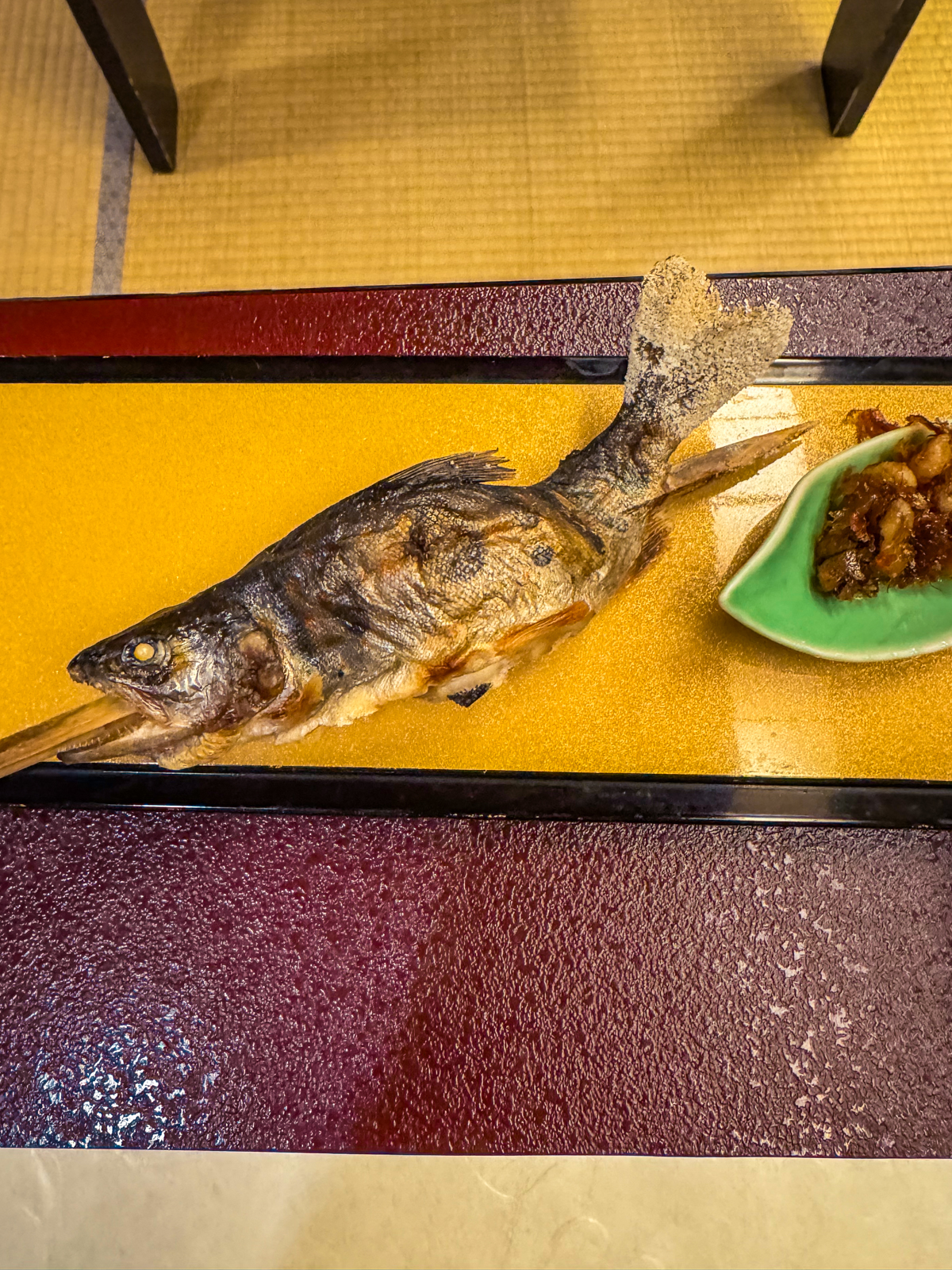
The highlight of the entire meal was next, four pieces of black A5 wagyu from Koshu, grilled vegetables, and our own stone grill and fire to grill it over. The showstopping wagyu was served alongside miso soup, chestnut rice, and Japanese pickles.



I loved the self-grilling experience as you can really experience and see the amount of marbling in each cut of meat. It was an experience just cooking the meat on the stone plate, make sure you keep an eye on it so you don’t ruin it by overcooking!

The wagyu, chestnut rice, miso soup, and Japanese pickles was the crescendo that overshadowed the rest of the meal for me. I thoroughly loved every single dish, and I couldn’t find enough ways to pair items together for a new way to delight my tastebuds.



The chestnut rice is worth another callout. It was my first time having this type of rice, and adding chestnut definitely enhances the nutty flavour profile of the rice. To pair with the fatty and delicious beef, every bite couldn’t last long enough.

To bring us back down to Earth from an experience that was too short, the final dessert course arrived. It was a persimmon jelly with whipped cream, candied celery, and dried persimmon on top.
This was a mindblowingly good dessert. I didn’t partake in the wagyu from earlier, so I didn’t experience the high that Kevin was coming down from. But I LOVE persimmons, especially dried ones. And the jelly was both light and fruity, while not being overly fragile. Every component of the dessert tasted amazing, even the candied celery (never thought I’d say this).
Kelly

Onsen and Other Facilities
In terms of other facilities, there’s a vending machine on the lower floors if you’re peckish after dinner. Also, there’s the gift shop situated just next to the lobby seating area if you were looking for some gifts.

However, the main attraction of a ryokan is its onsen facility.
When we checked-in, we reserved our private onsen slot after dinner so we can get a soak in and wind down for bed. It’s worth noting this reservation is free and available to all guests, but I highly recommend you make a reservation ASAP as slots can fill up quickly.
Despite having a private onsen attached to our room, this onsen reservation will permit us to use a full-sized ryokan onsen that would normally be public. As you can imagine, it’s much larger and nicer than the one on our terrace.

It’s important to point out that in Japanese culture, the onsens are gender segregated AND a fully nude affair. Not being used to this culture, we were not exactly jumping at the opportunity to see as many public onsens as possible. Despite this, I think even if you aren’t able to accept that cultural norm, you’ll have a great experience here. This is another reason that we booked the room with a small onsen.
Breakfast
After getting an amazing night of rest sleeping on futon, it was time for breakfast. We started the day with a quick soak in our private onsen and headed down to breakfast at 8:00. Both breakfast and dinner are served in the same room.
Breakfast was a less elaborate affair with a single service containing all of the dishes. I want to call out the tamago, fresh tofu, congee, smoked salmon, bean curd skin, fresh yuba, and rice.

Honestly, we never eat breakfast at home, and I didn’t find this breakfast spread to be that special. Nothing tasted bad per se, but combine usually not eating breakfast with a new cuisine, I wasn’t blown away about anything.
I was excited to check several things off my Japanese food bucket list with this breakfast: at the top of the picture you’ll see a simmering bowl of fresh soft tofu. This was served to us over a small fire so that it would continue to cook and firm up as we made our way through the other items. In the center of the picture, in the blue star-shaped bowl, are some pieces of konjac sashimi. Konjac is a root vegetable that is powdered and transformed into a translucent, rubbery food. I’ve previously marinated konjac to make Vegan Sashimi, but in Japan it’s often served as a delicacy in its own right. My excitement for the konjac definitely outweighed the taste, however. It was cold, chewy, with absolutely no flavour. I had to drench it in the yuzu soy sauce provided to add some life to the dish. Another item I was excited to try was tororo, which is in the yellow dish just below the konjac. Tororo is Japanese mountain yam (nagaimo) that has been grated into a sticky, slimy paste. Don’t get grossed out, but the texture is best described as snot-like. Again, it tasted just okay, nothing to write home about, but I was definitely glad I was able to try all these traditional Japanese foods.
Kelly
Service
Japanese culture as a whole is world-renowned for its service. The Japanese people even have a dedicated word for it: omotenashi.
Omotenashi comes from centuries old tea ceremonies and it doesn’t have a perfect English translation. Roughly speaking, it means to serve wholeheartedly / serve with mindfulness. This pillar of Japanese hospitality means you’ll receive some of the most attentive and thoughtful service in Japan. It’s important to know that while servers and staff will try to embody omotenashi, guests are expected to conform to their cultural traditions as well – such as their bathing culture and disdain for tardiness etc.
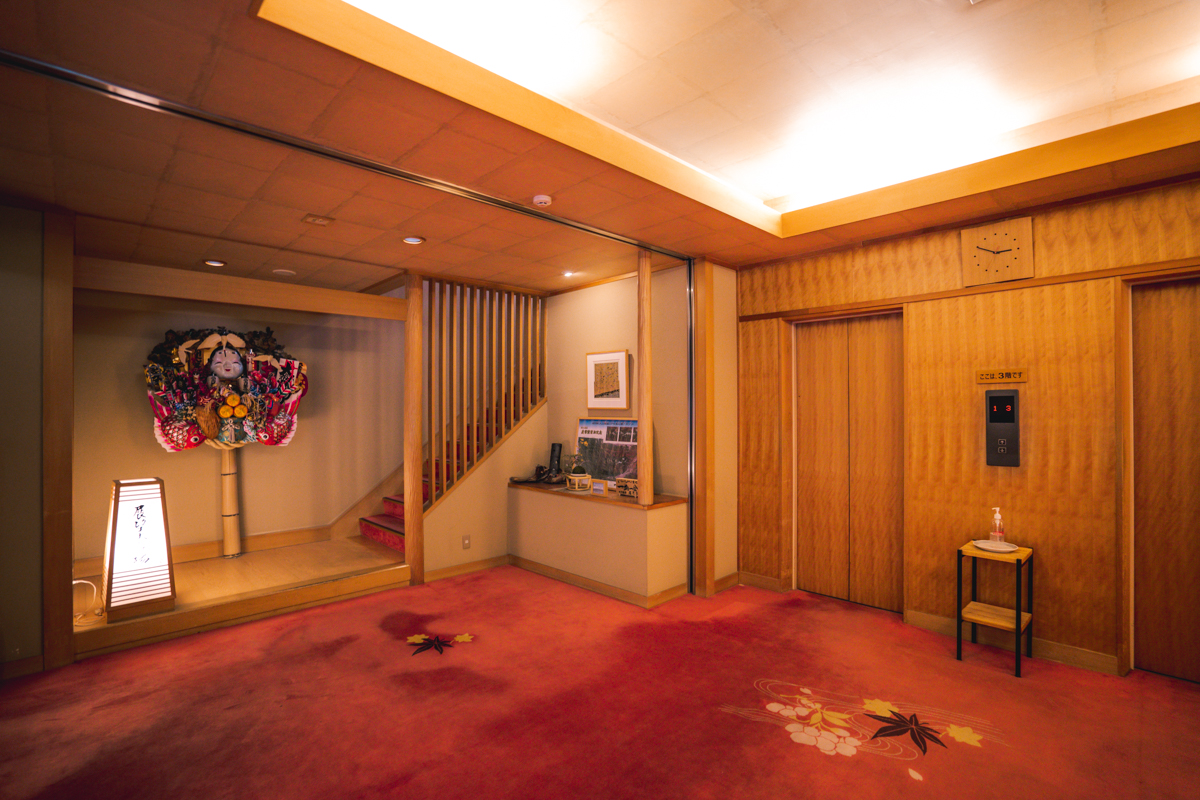
Service at Nishiyama Onsen was great, I would rate the service at the Ritz-Carlton, Kyoto better, but that’s because we had many more requests and stayed for 5 nights, instead of 1. Nishiyama Onsen staff were very attentive and proactive with welcoming us, securing a time slot for a private onsen, arranging transport, and facilitating any questions.
It isn’t perfect though, I’m disappointed with the way they shuttle guests to and from Minobu station. The bus driver and all of the staff are excellent and make the best of the situation; however, they either need a larger bus, a second bus, or do 2 pickups per day instead of 1. It was a horrible way to start and end the experience.
Conclusion
Nishiyama Onsen Keiunkan was our first ryokan experience and while it didn’t amaze me, that’s almost to be expected. We’re not the target demographic for a ryokan experience and it’s only natural that there are parts of the stay where a western-style hotel would have been more to our tastes.
Nevertheless, staying at a ryokan is about getting an appreciation and a minuscule understanding of Japanese culture. Evaluating Nishiyama Onsen Keiunkan with this lens makes the steep price point much easier to accept.
I was grateful to have finally experienced what a traditional ryokan is like – a 1,300 year old one at that. Considering that Nishiyama Onsen has been around since the invention of gunpowder, I’m sure there’s many more stories to tell.